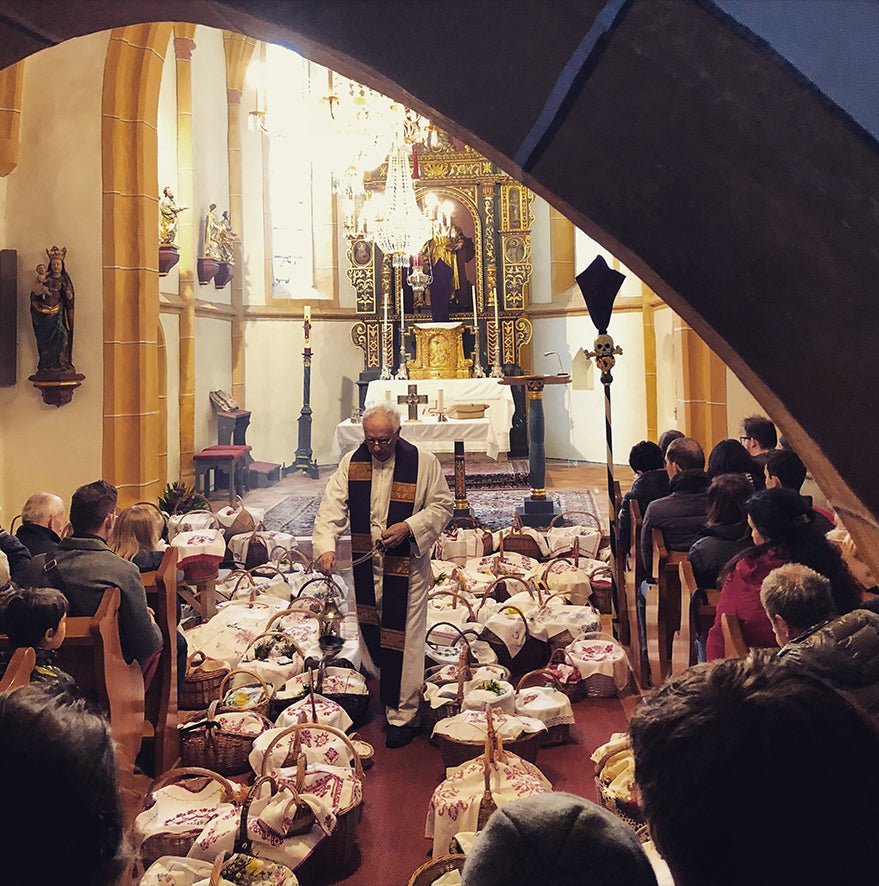I grew up in Carinthia, in the south of Austria — a place where mountains meet devotion, and every season carries a ritual.
Austria is deeply Catholic, yes, but more than that — it’s a land of rhythm. Of bells, bread, and belief. Even now, living in France with my husband and daughter, I find myself missing those small gestures that filled the air with meaning.
Each Easter began with a gentle preparation of the soul: cleaning the home, blessing the garden, and decorating every corner with hand-painted eggs, like small suns waiting to rise again.

On Good Friday, no meat was served — only silence and simplicity.
Then came Holy Saturday, my favorite day. Families carried embroidered baskets to church, each lined with a handmade cloth covered in cross-stitch symbols of faith. Inside: cooked ham, sausages, bright eggs, and Reindling — a soft Carinthian brioche rolled with sugar, cinnamon, raisins, and nuts.
Sweetness after restraint. Joy after waiting.
We are saved, even in the most challenging times.
That’s what Easter means to me — a reminder that light always returns, even when the world feels heavy.

The priest has to give the benedictions to all the food in church. Once this is done, we can eat all the delicious things at home. This is our typical Easter meal.
Of course, we also go to church on Sunday and continue to celebrate, which means in Austria to eat even more.
I am happy to share with you some traditions and beliefs from the Alpine region, from my childhood to share the essence with you of the celebration, whether you are Catholic or not: "We are saved, even in the most challenging times". Especially in this severe actual health crisis in this world, we have to have a positive belief.

I
Ancestral Beliefs: The Magic of Alpine Easter
Nadine-Simon Stegelmaier writes beautifully about these old rituals in her book Raunächte. She reminds us that long before churches and crosses, these traditions were about life’s return — nature awakening, fields protected, homes blessed.
Easter, in its deepest roots, is not just about resurrection. It’s about rejuvenation and renewal — for the land, the body, and the spirit.
Easter Water: Collected from springs at dawn to bless and heal. If you washed your face in it, they said, you’d stay young and radiant.
Easter Fire: Lit in the dark to celebrate the sun’s victory over winter — the divine flame carried from the church into every home.
Easter Lamb: A sacred meal turned symbol of rebirth — life emerging from sacrifice.
Easter Eggs: Closed shells, sleeping life — cracked open to reveal resurrection itself.
Even today, in small villages across Austria and Bavaria, boys collect brushwood for the Easter fire, and families bake holy bread to share with forest animals — an offering back to the earth that feeds them.
These are not just customs. They are echoes — small rituals that say: life continues.
Folklore, Luck & Little Wonders
Some beliefs sound almost like fairy tales:
Those born on Easter Day are said to live under a lucky star.
Washing your feet in a stream on Easter morning makes you strong for the year.
Eggshells buried in the garden promise fruit-filled trees.
And if you lie at a crossroads on Easter night, the devil himself may offer you gifts — if you dare not laugh.
The Easter season was seen as a portal of magic, when nature and spirit danced close. The air itself shimmered with possibility.
So our Easter is a mixture of ancient traditions that were filled with Christian faith. It is the same with the customs and manners that surround these days. Many ancient backgrounds have been mixed with more recent customs.

The Easter Lamb: The Easter lamb also belongs to the Christian Easter. The Easter lamb originated from the Jewish Passover ritual, where a lamb was slaughtered and eaten. The lamb is slaughtered in memory of God. In the Christian church, it has become symbolically the Lamb of God and is represented with the flag, the sign of victory. The priest transforms the wine and bread into flesh and blood in words. The lamb is understood as a sign of life.
Easter eggs: The custom of giving eggs for Easter has different origins. The egg was considered to be the origin of man or even of the universe early in cultural history. Already in the early Christian period, it was a symbol of life and resurrection, so that an egg was placed in the grave of the dead. The egg holds something hidden, like a closed grave. Something living finally hatches from a dead body. This makes the relationship to the resurrection of Christ clear.
The Easter candle: The Greek, Jewish, Roman, and Christian light traditions unite in the Easter candle. The light is considered a sign of life. The Easter candle and the light celebration at the beginning of the liturgy have their earliest roots in the custom of the old church to illuminate the Easter night with numerous candles. In addition, there was a custom in the city of Rome to light up the Easter night celebration with two man-sized candles.

Old customs from popular belief
This is how you should have finished the work started at Easter; otherwise, you would never be able to finish it.
The children were given new clothes. If this was not possible, they were switched to "Osterkälbli".
In the Bavarian Forest, it was said that you could start walking barefoot directly at Easter without being damaged, because then the earth was consecrated.
Those born on Easter Day were considered special children of luck.
In many regions, people would whip loudly or whip pots to pieces as part of the task to drive out the evil winter spirits.
On Easter morning, branches are hung in the fresh shoots in the barn to protect the animals from witches.
If someone died between Easter and Pentecost, he was immediately saved.
When the Pope gave the blessing to the whole world at noon in Rome, the farmer also went to his field, knelt, and made the sign of the cross to direct him to his fields.
You baked pancakes on Easter Sunday morning and carried the eggshells to the field, so the grain was immune to weather damage.
The remains of the Easter lamb and the shells of the colored eggs were buried in the garden, so the trees bore plenty of fruit. Eating soberly from the pastries hanging on the palm bushes on Easter morning protected against all stomach diseases. Everything that should not go out during the year was consecrated at the Easter fair.
The ham, in particular, was a well-known holy meal. Before the lunch table, something had to be eaten out of the holy basket, which protected against bodily harm. In Lower Bavaria, part of the consecrated food was carried into the forest for the forest animals.
In many areas, horseradish was eaten with spoons before Easter breakfast to commemorate the bitter sufferings of Christ.
At Easter, the world of spirits is on the move and all sorts of magic express its power. For example, on Easter night, all the beginners are on the move.
If you lie on a crossroads on Easter night from 10 p.m. to 11 p.m. and, despite all appearances, you neither laugh nor cry, the devil comes in the form of a hunter and gives you all kinds of gifts.
The dowsing rod is christened on the first Easter day.
You have to be vigilant against witches on Easter night. Therefore, shots echo through the night to drive them away.
According to widespread belief, God releases the souls on Easter night until Pentecost so that they can roam around on earth.
In the Easter days, trees and springs are suitable for all kinds of oracles. For example, you pick palm kittens and give them the names of the boys in the village. Then you sprinkle them in the water, and the kitten that swims the longest becomes the future husband.
"I hope these beliefs speak to you in one way or the other, as they are profound and grew over centuries. Something may work out for you.
I want to share with you my best recipe for the typical Carinthian Reindling, which we traditionally eat at Easter; it is simply super delicious."
Wishing you a peaceful and healthy Easter Weekend,
Yours sincerely,
Michaela

Dish dessert // Country and region Carinthia
Servings of 3 Reindling
Ingredients
1 kg of wheat flourT700 (350gr of it for steam = "Dampfl"
50 g yeast for steam (Dampfl)
20 g cane sugar for steam (Dampfl)
10 g honey for steam (Dampfl)
350 g water for steam (Dampfl)
110 g milk for dough
110 g water for dough
30 g rum for dough
18 g salt for dough
120 g cane sugar for dough
Lemon for batter
Vanilla for dough
160 g butter for dough
1 egg for drive
1 yolk for drive
Cinnamon for filling
Cane sugar for filling
Cocoa for filling
Raisins for filling
Chopped walnuts for filling
Clarified butter for brushing for filling
Butter for spreading out the form
Instructions
Preparation Dampfl:
To prepare the steam, form a well into the sifted flour (about 350 gr) add yeast, sugar, honey and water to the well, stir "pudding-like" and let stand for 20 minutes.
Preparation of dough:
Then whip the egg and yolk for the drive and mix with the remaining dough ingredients (except the butter) to form a smooth dough. Add the butter during the kneading phase (2nd course = fast course). Let the dough rest well covered for at least 30 minutes.
Preparation filling:
While the dough is resting, coat the baking tins well with butter, this will refine the taste of the rekindling
For the fullness, mix the cinnamon with cane sugar and cocoa. Prepare the raisins soaked in rum and some water overnight. Crush or roughly chop the walnuts.
Further preparation:
Now divide the dough into three equal parts and let it stand again for 20 minutes. It needs enough time and relaxation to develop the full taste and to open well.
Then roll out the dough, spread with warm clarified butter, spread the cinnamon-sugar mixture on top and then sprinkle the rum raisins and walnuts over them according to taste.
It is important to roll the dough tightly together (at least 4 turns). Then put the beginning in the end and put it in the buttered form.
Then let it rest well covered for about 45 minutes.
Preheat the oven to about 175 degrees Celsius and bake for about 45 minutes. Immediately after baking, throw the Reindling out of the mold while the cinnamon sugar that has leaked is still warm.

Nadine-Simone Stegelmaier's fascinating book "Rauhnächte". I hope it will exist soon also in English!


